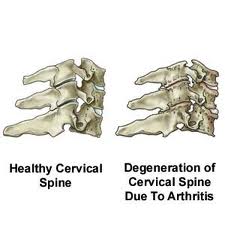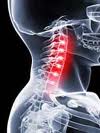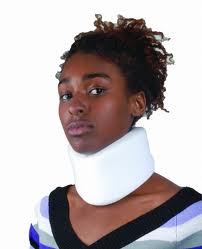Cervical spondylitis is a common degenerative condition of the cervical (neck) spine that most likely is caused by age-related changes (wear and tear) in the intervertebral discs and vertebrae of the neck. Research has shown that CSM (cervical spondylotic myelopathy) is the most common cause of non-traumatic weakness in limbs and a persistent stiffness and nagging pain in the neck.
‘Spondylo’ is a Greek word-meaning vertebra. Spondylitis (or Spondylosis) means changes in the vertebral joint characterized by increasing degeneration of the intervertebral disc with subsequent changes in the bones and soft tissues.
Most often in people above the age of 40, the intervertebral discs get progressively dehydrated and they become more compressible and less elastic. Mineral deposition starts occurring in the intervertebral disc resulting in secondary changes and reducing the gap between intervertebral discs.

Symptoms
Clinically, several groups of symptoms, both overlapping and distinct, are seen: neck and shoulder pain, sub-occipital pain and headache, radicular symptoms, and cervical spondylotic myelopathy (CSM).
The most common symptom is intermittent persistent neck and shoulder pain. The pain can be chronic or episodic, associated with long periods of remission.
- Neck pain is often accompanied by stiffness which progressively worsens. Pain may also radiate to the shoulders or to the occiput. Many patients present with interscapular pain, pain in the arm, forearm, and/or hand pain.

- Non-specific headaches occurring mostly in the sub-occipital region (lower part at the back of head) and this pain radiates to the base of the neck and to the vertex (top) of the head.
- Patients without any history of trauma present with pain, loss of sensation, abnormal sensations and weakness, or a combination of these symptoms. These symptoms are often present in the shoulders, arms and rarely in the legs.
- Occasionally, the pain may be atypical and present as chest pain or breast pain (false angina).
- Patients with myelopathy can present with symptoms such as difficulty in writing; nonspecific, diffuse weakness; and abnormal sensations.
- Loss of sphincter control and urinary incontinence occurs in very rare cases, but some patients complain of urgency, frequency, and urinary hesitancy.
Homoeopathy treatment offers good relief as well as prevents the further degeneration in cases of cervical spondylitis.
Causes
Cervicalspondylitis results due to abnormal wear of the cartilage and bones of the neck (cervical vertebrae) with degeneration and mineral deposits in the cushions between the vertebrae.(cervical disks). This is more common after the age of 40 years.
Risk factors:
- Repeated occupational trauma e.g., carrying loads on head, professional dancing, gymnastics may contribute.

- Predisposition to development of cervical spondylitis has been reported in certain families; a genetic cause is possible.
- Smoking also may be a risk factor.
- Conditions like congenitally fused spine, cerebral palsy, Down syndrome etc. may be risk factors for spondylotic disease.
- Doing work that demands minute concentration, people who constantly work by bending their neck
- Computer professionals, bike users
- Travelers who travel a long distance and sleep in sitting position
- Telephone operators or persons who often cradle the phone on the shoulder
- Habit of holding neck in one position, drivers who keep the neck in the same position for a long time, watching TV in abnormal positions or when lying down
- Old people
Do’s
- Do regular exercise to maintain neck strength, flexibility and range of motion.

- Use firm mattress, thin pillow.
- Do turn to one side while getting up from lying down position.
- Wear a cervical collar during the day.
- Regularly walk or engage in low-impact aerobic activity.
- In order to avoid holding the head in the same position for long periods, take break while driving, watching TV or working on a computer.
- Use a seat belt when in a car and use firm collar while traveling.
- When in acute pain take rest, immobilize the neck, and take medications as directed.
Don’ts
- Avoid sitting for prolonged period of time in stressful postures.
- Avoid running and high-impact aerobics, if you have any neck pain.
- Do not lift heavy weights on head or back.
- Avoid bad roads, if traveling by two or four wheelers.
- Do not drive for long hours; take breaks.
- Avoid habit of holding the telephone on one shoulder and leaning at it for long time.
- Do not take many pillows below the neck and shoulder while sleeping.
- Do not lie flat on your stomach.
- In order to turn around, do not twist your neck or the body; instead turn around by moving your feet first.
Do not undergo spinal manipulations if you are experiencing acute pain.





